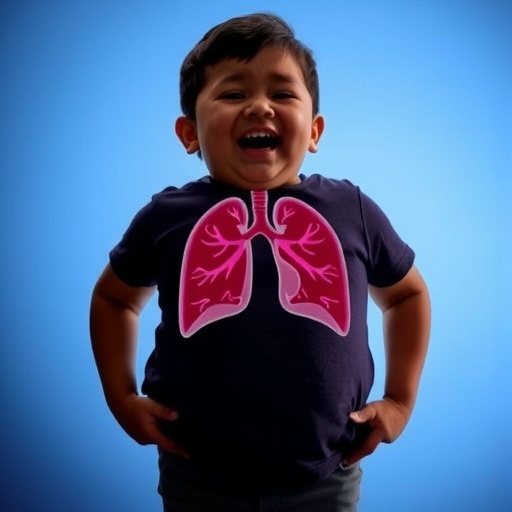Title: Unraveling the Complex Web: The Impact of Child Obesity on Respiratory Muscle Strength and Lung Function
In recent years, the global epidemic of childhood obesity has raised significant public health concerns. The alarming increase in overweight children not only affects their physical appearance but is also linked to various health complications, particularly respiratory issues. A study published in BMC Pediatrics has shed new light on the intricate relationship between child obesity, respiratory muscle strength, and lung function, exploring how these factors are influenced by variables such as sex, age, and maturity offset status. The investigation highlights how understanding these interconnections is crucial for devising effective interventions and promoting healthier lifestyles among children.
Childhood obesity is characterized by an excessive accumulation of body fat and is typically quantified using the Body Mass Index (BMI) metric. As children transition from infancy into adolescence, their body compositions change, and so do their metabolic demands. Obesity has been shown to impair respiratory function by influencing lung volumes and airflow dynamics. This relationship is pivotal as respiratory strength and function are vital for children’s overall health and development, directly affecting their exercise capacity and quality of life.
A growing body of evidence indicates that excess body weight can lead to altered respiratory mechanics. Children with obesity often exhibit reduced lung volumes, particularly the expiratory reserve volume, and diminished respiratory muscle strength. The implications are significant—children with these deficits frequently face challenges in performing physical activities, leading to a cycle of inactivity and further weight gain. The need for targeted studies that delineate the specific aspects of respiratory function impacted by obesity has hence become increasingly urgent.
The recent study conducted by Mello and colleagues examined a diverse group of participants, utilizing sophisticated methodologies to assess respiratory muscle strength alongside pulmonary function tests. This approach not only quantified respiratory metrics but also allowed for comprehensive analysis based on age and sex differences among subjects. Interestingly, the study found that the interplay between obesity and respiratory function does not uniformly affect all children; rather, age and maturity offset status were indicative of how these variables manifested in pediatric populations.
Sex appeared to play a pivotal role in the study’s findings. Data suggested that boys and girls respond differently to increases in body weight concerning respiratory muscle strength. This revelation has profound implications for how health professionals approach obesity management in children, indicating that gender-specific strategies may be required to enhance lung health in overweight children.
In terms of maturity offset, the research underscored the importance of acknowledging growth and developmental changes when addressing the impacts of obesity on respiratory functions. Notably, children who have progressed further in physical maturity exhibited distinct respiratory characteristics compared to their less mature counterparts. This differentiation is crucial when formulating health policies since it can guide targeted interventions for preventing respiratory complications among preadolescent children at risk of obesity.
The pressing need to address the burgeoning rates of childhood obesity cannot be overstated. Clearly, early intervention strategies that educate families about nutritional choices, physical activity, and lifestyle changes must be integral to public health initiatives aimed at combating this crisis. Moreover, expanding access to resources that encourage active play and healthy eating in schools and communities could facilitate substantial improvements in children’s health trajectories.
Furthermore, health professionals must recognize the multifaceted nature of obesity and its consequences on respiratory health. Understanding the nuanced relationship between body weight, sex, age, and lung function can empower healthcare providers to tailor their approaches when diagnosing and treating affected children. This integrated perspective can lead to more effective interventions that not only target weight loss but also aim to improve respiratory function.
As this research progresses, the lessons learned from such studies can influence public health strategies on a broader scale. Educational campaigns highlighting the risks associated with childhood obesity and the importance of lung health are essential. Schools can be pivotal in implementing policies that promote regular physical activity, nutritious meals, and wellness programs, hence fostering a health-conscious culture among children.
The study’s results also open avenues for additional research focusing on the long-term outcomes of obesity on respiratory health as children transition into adolescence and adulthood. Understanding how childhood obesity alters respiratory function and muscle strength over the lifetime of affected individuals will be vital to mitigating the chronic health conditions associated with obesity and poor lung health.
In conclusion, the intricate relationship between child overweight and obesity, respiratory muscle strength, and lung function presents crucial insights for future public health endeavors. By actively engaging in research and fostering an informed understanding among healthcare providers, policymakers, and families, it may be possible to combat the rising tide of childhood obesity while safeguarding the respiratory health of future generations.
Ultimately, this knowledge will not only contribute to improved clinical practices but also catalyze community-level changes aimed at promoting healthier lifestyles for children worldwide. The interplay of obesity with respiratory health is an urgent issue that begs for continuous exploration, collaboration, and action for the benefit of children everywhere, marking the necessity for an ongoing commitment to research in this critical field.
Subject of Research: The relationship between childhood obesity and respiratory muscle strength and lung function.
Article Title: The relationship between child overweight/obesity and respiratory muscle strength and lung function considering sex, age, and maturity offset status.
Article References:
Mello, J.B., da Silva Mello, M.F., Oliveira-Silva, I. et al. The relationship between child overweight/obesity and respiratory muscle strength and lung function considering sex, age, and maturity offset status.
BMC Pediatr 25, 881 (2025). https://doi.org/10.1186/s12887-025-06226-y
Image Credits: AI Generated
DOI:
Keywords: Childhood obesity, respiratory function, lung health, respiratory muscle strength, age, sex differences.




